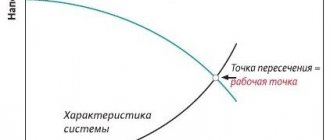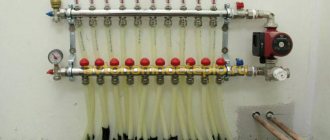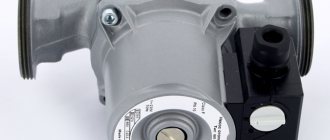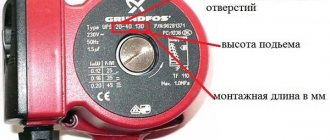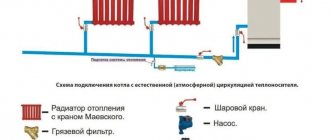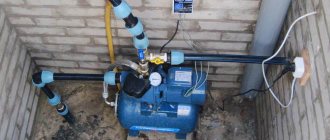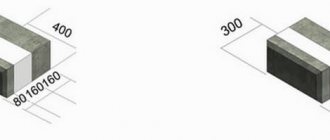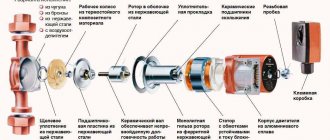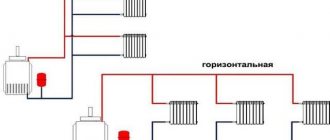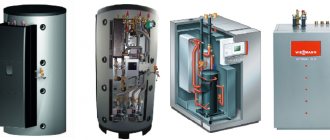Here you will learn:
- Structure of heating systems
- What is an uninterruptible power supply?
- Types of uninterruptible power supplies
- How to choose an uninterruptible power supply
- How to make an uninterruptible power supply for a heating pump with your own hands
- Factory models
The use of heating systems with forced circulation of coolant forces us to consider providing backup power for the pumps used in them. Otherwise, cutting off the power will cause the circuit to stop. For power backup, an uninterruptible power supply is required for the heating pump. Using charged batteries, it will provide the pumping unit with alternating current at the required voltage. It is this equipment that will be discussed in our review.
Structure of heating systems
Thin metal-plastic and metal pipes used in modern heating systems do not allow for natural coolant circulation. Also affected by the absence of slopes, the presence of a large number of connecting fittings, the minimum internal volume of radiators and many other factors. To ensure that the coolant can circulate freely through the pipes and deliver heat to all corners of the house, circulation pumps are installed in the heating circuits.
Pumps used in heating are built according to a “wet” rotor design. Thanks to this, they are compact and silent. The pump units are powered from a household single-phase network with a voltage of 220 Volts. Despite the fact that rolling power outages are no longer practiced, the stability of the supply of electricity to houses and apartments remains a sore domestic issue.
In the absence of an uninterruptible power supply, each power outage leads to difficult circulation or even its cessation. The house becomes cooler, and the heating boiler, diagnosing overheating of the boiler water, turns off. If the “lights” are turned off for several hours and there is no thermal insulation, soon the air temperature will begin to drop - the conditions for staying in the rooms will not be the most comfortable. There is only one conclusion - you need an uninterruptible power supply.
Self service
If you managed to assemble a UPS for the boiler with your own hands, then servicing it is often not difficult . You will only have to change the batteries at certain intervals and periodically check the integrity of the entire system.
It is better to install the UPS either in the basement or semi-basement so that it does not occupy the space of the apartment, but moisture penetration, of course, is unacceptable in any case, so placing it in a small closet would be a good option.
What is an uninterruptible power supply?
An uninterruptible power supply is an electronic device that provides uninterruptible power to a heating pump. To do this, it contains a battery that stores electricity from the network. When the mains power is turned off, the uninterruptible power supply (UPS) almost instantly switches to operation from the battery (or from several batteries). This device consists of several main components:
Please note that not every uninterruptible power supply is a stabilizer - this is a separate option and may not be on board.
- Battery – accumulates electricity, and during a power outage, releases it to the load;
- Voltage converter – converts direct current with a voltage of 12 Volts into alternating current with a voltage of 220 Volts;
- Filter – filters out impulse noise in uninterruptible power supply systems with pulse converters;
- Stabilizer – ensures stabilization of the output voltage within the permissible error.
Also, all UPS have charge control circuits.
Why do you need a UPS?
Modern heating systems are equipped with devices that operate on electric current. This applies to both boilers with an electronic control unit and conventional pumps. Accordingly, when electrification stops, the circuit stops working, since there is no coolant circulation in it. This is a serious problem in regions where power outages occur frequently. Rolling blackouts are also not uncommon in dacha cooperatives, especially in winter. To avoid getting into a situation where the risk of defrosting becomes real, you can:
- assemble the gravity circuit;
- Provide the heating system with an emergency power source.
An alternative power source can be:
- electric battery;
- generator.
If you choose batteries, then a special device must be installed between the power source and the device, which acts as a kind of intermediary. You won't be able to wire the wires directly. To use the generator you need to install a voltage stabilizer. As a result, the cost of a generator with a stabilizer will greatly exceed the price of batteries with an uninterruptible power supply (UPS for the heating pump and boiler).
As you understand, the gravity circuit is a thing of the past and many owners of such heating install a pump on it. As for sealed circuits, circulation in it by gravity is impossible a priori, only with the help of a supercharger. This means that the only acceptable solution is to install an emergency UPS for the heating pump. Popularly called “bezpereboynik”.
Secondly, all modern boilers, even solid fuel ones, are connected to the electrical network. It follows that the installation of a UPS for a heating circulation pump is carried out in circuits with solid fuel heaters without an electronic unit.
Types of uninterruptible power supplies
When choosing an uninterruptible power supply for a heating circulation pump, you should pay special attention to its technical characteristics. First, let's define the types of this equipment:
- Linear uninterruptible power supplies (backup) are extremely simple. There is no stabilization of the input voltage; when powered from the mains, it fluctuates over a wide range. When the power supply is turned off, the equipment is powered by a built-in or plug-in battery;
- Line-interactive uninterruptible power supply units – models with voltage stabilization function. They are built on the basis of autotransformers;
- UPS for a double conversion heating circulation pump is the most complex uninterruptible power supply. The first converter outputs a constant voltage, from which the batteries are charged. The second converter outputs alternating current with a voltage of 220 Volts.
Uninterruptible power supplies with double conversion are complex, but the most stable. They do not use direct power supply to consumers from the mains - the current undergoes double conversion.
The optimal purchase for powering a circulation pump would be an uninterruptible power supply with double voltage conversion (inverter for a heating pump).
Operating principle and design of the UPS
The emergency power source, depending on the design, can perform the following functions:
- Automatic switching to battery power;
- Converting DC voltage 12V to AC 220V;
- Network interference filtering;
- Mains voltage stabilization.
The transfer of power from the circulation pump to the battery, voltage inversion and filtering from impulse noise are performed by all UPSs, and stabilization is carried out only by devices equipped with the appropriate unit.
Domestic UPS. A large assortment of inverter uninterruptible power supplies for boilers and heating pumps is presented by domestic manufacturers, positive reviews of whose products you can easily find on the Internet. You can get acquainted with the company's products on the website of the official representative of Energia.ru.
The following models of emergency power supplies can be used in power supply systems:
- Backup UPS;
- Linear interactive;
- Double inverting UPS.
Reserve
Emergency sources under normal conditions provide power to the consumer directly from the network, and when it is turned off, they automatically switch to the battery. The DC voltage from the battery is first supplied to a voltage converter, where it becomes alternating and rises to 220 volts. The mains voltage is not stabilized, and to block mains impulse noise, the device uses a passive filter.
Linear interactive
The linear-interactive backup power supply has one significant difference. It uses a simple stabilizer to equalize the network voltage. It is made according to a circuit using an autotransformer, where when the input voltage changes, an electronic switch connects the corresponding windings. The stabilization circuit allows you to obtain an output voltage that is only slightly different from the nominal one. A voltage converter and filter are also included in this device.
Inverter
A power supply using double inversion is a design that is fundamentally different from the previous two.
In this device, the mains voltage is rectified, while part of the energy is stored in a battery of capacitors. In the second inverter, secondary conversion of direct current to alternating current occurs. Capacitors serve double duty. If the voltage is too high, then its excess is stored in them, and if the voltage decreases, the shortage is replenished with accumulated energy.
The entire conversion process is controlled by a microcontroller with a quartz oscillator, which ensures high accuracy of not only voltage, but also frequency. Each uninterruptible power supply for a heating circulation pump contains in its design a charger for recharging the battery.
Domestic UPS. A large assortment of inverter uninterruptible power supplies for boilers and heating pumps is presented by domestic manufacturers, positive reviews of whose products you can easily find on the Internet. You can get acquainted with the company's products on the website of the official representative of Energia.ru.
How to choose an uninterruptible power supply
You can buy an uninterruptible power supply at any store that sells plumbing and heating equipment. There is an impressive variety of models here – it’s easy to get confused. Let's see how to choose the right uninterruptible power supply.
Selection by type
The main advantage of inverter uninterruptible power supplies is that they provide a so-called continuous sine wave - when switching from the network to the battery, the output current is not interrupted.
Of all the above UPSs, the models with double conversion (inverter) stand out with the best characteristics. Their advantages are good stabilization, the correct shape of the output voltage (sinusoid, and not its stepwise approximation or other shapes). They are also characterized by the absence of high-frequency interference at the output. Thanks to this, inverter uninterruptible power supplies can be used to power boilers with sensitive electronics on board. But they also have a minus - they are noisy, since coolers are installed inside.
Linear uninterruptible power supplies have the lowest cost. When feeding heating system pumps, they do not stabilize the mains voltage. Due to the use of the simplest converters, the shape of the output current is far from ideal - because of this, the circulation pump may fail, and you will be left without heating. But these UPSs have the highest efficiency.
Selection by power
Here you need to look at the technical data sheet for the pump and clarify its power consumption. We multiply the resulting value by 3 and obtain the maximum power of the uninterruptible power supply. The need for multiplication is explained by the fact that the heating pump is a reactive load. And at the moment of start, it consumes power 2-3 times higher than the rated one. This is precisely why we have provided a substantial reserve.
Battery capacity
Small uninterruptible power supplies can last only a few hours on batteries. On-board batteries most often have a small capacity. If power outages in your area are frequent and long-lasting, we recommend choosing a UPS with a battery capacity of a hundred amperes - depending on the power of the pump used, it can work for almost a day or even more.
To ensure long-term heating operation from a backup power source, choose uninterruptible power supplies with external plug-in batteries. The optimal type of battery is gel, maintenance-free.
Input and output voltage error
An important parameter for an uninterruptible power supply. The smaller the output error, the better - ideally no more than 5%. The greatest discrepancies are observed at the input, therefore, for correct operation of the heating, you should choose an uninterruptible power supply that can operate in a wide range of supply voltage - from 150 to 250 Volts.
Advantages and disadvantages of different types of UPS
There is no ideal emergency power source, and each model has its own advantages.
For a backup source they are as follows:
- High efficiency;
- Low noise and heat generation;
- Lowest cost.
Disadvantages of a backup power supply:
- Long switching time;
- Distorted output voltage waveform;
- There is no possibility of amplitude and frequency correction.
The parameters of the linear-interactive source are slightly better:
- High efficiency;
- No noise;
- Voltage stabilization using an autotransformer.
Minuses:
- Long switching times;
- Low accuracy;
- The voltage shape is close to a trapezoid;
- Low-budget models exhibit a frequency deviation.
We invite you to watch a good video about the types and criteria for choosing a UPS for heating boilers and circulation pumps:
Inverter UPS. The double inverting emergency power supply system has a number of undoubted advantages that place this design in a leading position.
Pros:
- Work in a wide range of mains voltage;
- High stabilization accuracy;
- Lack of time to switch;
- Exact frequency matching;
- Absence of any interference at the output;
- Ideal form of tension.
Minuses:
- High price;
- Constant noise from the fan.
An uninterruptible power supply for a heating pump must have one very important parameter - a sinusoidal output signal. If the signal has the shape of a meander, trapezoid or stepped sine wave, the pump motor will work hard, which will ultimately lead to irreversible consequences and replacement of the motor. A clear sinusoid is produced by a source made according to a double conversion circuit. In some cases, a backup UPS can be used. This is acceptable when the supply voltage is turned off extremely rarely and the heating system pump operates almost constantly from the network.
How to make an uninterruptible power supply for a heating pump with your own hands
Many people who are inclined to save money are accustomed to doing everything themselves. This is commendable, as it indicates the presence of brains and direct hands. To make a UPS for a heating circulation pump with your own hands, you will need additional knowledge in the field of electrical engineering - you need to assemble a converter (also known as a charge controller). If you don’t have the appropriate knowledge, then it’s better not to take it on.
As an introductory example, we present a circuit diagram of an uninterruptible power supply for a heating pump using domestic radio components.
Precautions and possible errors
- First of all, if you decide to make an uninterruptible power supply for a heating pump with your own hands, you need to wear gloves so as not to receive an electric shock from exposed wires or contacts.
- You should carefully examine the wires - they should not have even slight damage, because... A short circuit is very dangerous and can not only harm human health, but also cause a fire.
- For the system, you should connect several batteries (it is best to take 2-4 fully charged ones) and connect them in parallel.
- In no case should you save money and buy cheaper devices, since the quality and service life usually correspond to the price.
- Do not connect everything to the device; use it exactly for those devices for which it is designed for its power. However, for computers, as a rule, this power is quite enough, the main thing is that the total power does not exceed the maximum permissible.
- The best choice, as experts advise, would be models with phase-dependent equipment.
Factory models
You can buy an uninterruptible power supply suitable for its characteristics in heating and plumbing stores. They are also sold in online stores. Final prices vary depending on the manufacturer, type of equipment and technical specifications. We will look at the most popular models and give their estimated cost.
Energy PN-1000 with 75 A battery
We have a simple uninterruptible power supply with a good battery capacity of 75 A/h. With a pump power of 100 W, the battery life will be about 8 hours. The peak power is 1000 W, which is enough for any reactive load. At the output, the device produces a pure sine wave. And it refers to line-interactive UPSs, characterized by high efficiency and an affordable price.
The cost of the model on the domestic market is about 260,000 rubles. Modifications with different battery capacities are also available for sale:
- At 100 A/h – up to 11 hours when operating with a load of 100 W;
- At 55 A/h – up to 6 hours when operating with a load of 100 W;
- At 200 A/h - up to 23 hours when operating with a load of 100 W.
If power outages in your area are frequent and long-lasting, we recommend paying attention to the latest modification - its cost is 36-37 thousand rubles.
SVC DI-600-F-LCD
A compact uninterruptible power supply that can work with boilers and pumps, ensuring continuous circulation of coolant in the heating system. It belongs to the category of linear-interactive and produces a pure sine wave at the output without any distortion. The equipment does not require user intervention in its operation and provides an output voltage error of no more than 10% - this is the norm for pumps, but for boilers it could be less.
The speed of switching to operation from the battery does not exceed 20 ms. There is no built-in battery here; an external battery with a capacity of up to 200 A/h is connected to the uninterruptible power supply - this will ensure up to 24 hours of autonomous operation of the heating system. The peak load for this model should not exceed 360 W. The estimated cost of the model is 6.5-7 thousand rubles.
Tieber T-1000
If you need an uninterruptible power supply with a maximum capacity, from which the pump can operate for up to two days, you should look at this model.
It works with two batteries with a capacity of up to 200 A/h each. The manufacturer recommends using maintenance-free gel batteries, as they do not emit harmful gases into the atmosphere - this is important for residential premises. The maximum load power is 800 W. An uninterruptible power supply can power fairly powerful pumps and heating boilers, as well as units of water heated floors. The output voltage form is a pure sine wave, as required by pumping equipment motors. The device is designed for floor installation; batteries are placed next to it. The maximum charging current is 12 A/h.
Examples of power calculation and selection of UPS for circulation pumps
Let's calculate several options for pumps:
Grundfos Alpha2 L 32-60Grundfos UPS 32-60Wilo Star RS15/6-130UNIPUMP UPC32-60
We believe that we are tasked with selecting kits for two battery life options: 6-8 and 14-16 hours with continuous pump operation.
Pump model Max. powerEnergy efficiency classStarting powerPower reserve 20%Min. UPS power for pump protection
| Grundfos Alpha2 L 32-60 | 45 W | A | 45 W * 1.3 = 59 W | 59 W * 1.2 = 71 W | 500 VA / 300 W |
| Grundfos UPS 32-60 | 60 W | B | 60 W * 5 = 300 W | 300 W * 1.2 = 360 W | 1000 VA / 600-800 W |
| Wilo Star RS15/6-130 | 84 W | B | 84 W * 5 = 420 W | 420 W * 1.2 = 504 W | 1000 VA / 600-800 W |
| UNIPUMP UPC32-60 | 100 W | Unknown | 100 W * 5 = 500 W | 500 W * 1.2 = 600 W | 1000 VA / 600-800 W |
Price
There are 2 lines of stabilizers designed specifically for circulation pumps of the heating system - Teplom and Slope:
Teplokom STT 222/500
It was created for heating systems where boilers with an open or closed combustion chamber are installed. It has a microprocessor control system, as well as technology that allows you to start the device immediately after the power supply is restored. It has wall mounts and can also be installed on the floor.
The price of such equipment does not exceed 3 thousand rubles.
On sale you can find a model that can be installed outdoors thanks to a housing that does not allow moisture to penetrate inside. The cost of such equipment will be slightly higher and reaches 4.5 thousand rubles.
Skat ST 1515
It is a UPS equipped with a voltage stabilizer. It is designed for certain voltage fluctuations in the network - up to 10% in each direction.
Its cost can reach 6 thousand rubles.
